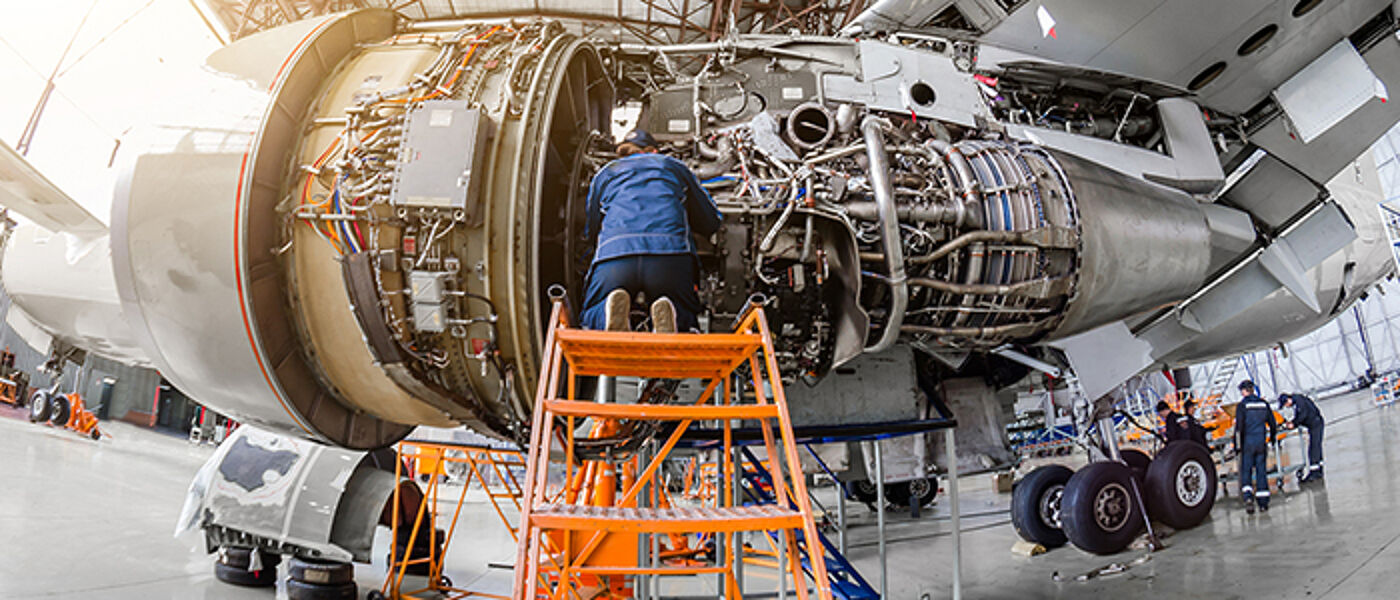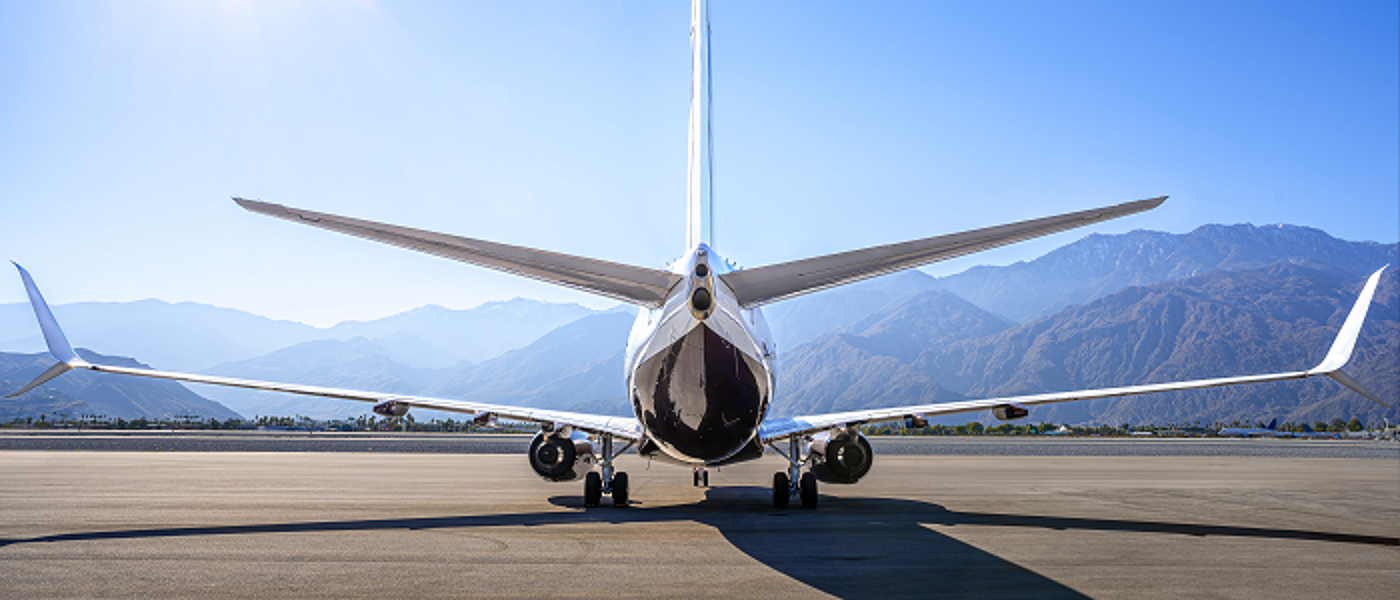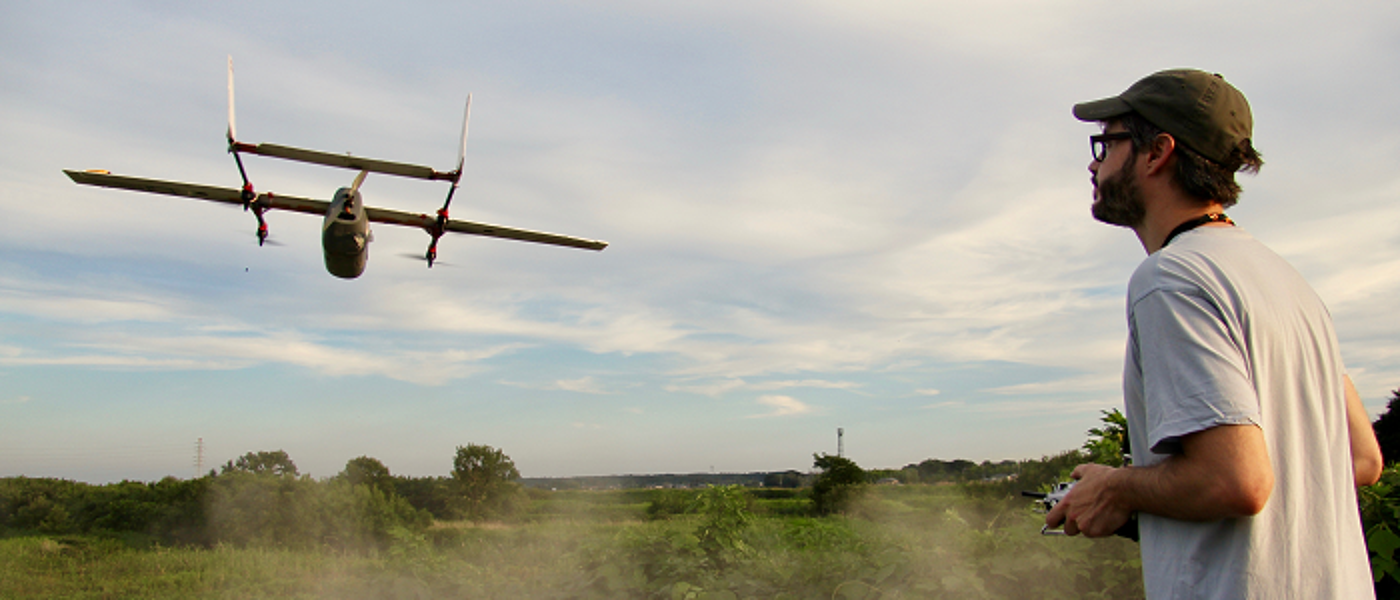Autonomous Systems and Connectivity
We tackle multidisciplinary challenges to develop future technological capabilities that deliver uninterrupted connectivity that is interoperable between aircraft, helicopters, drones, future electric vertical take-off and landing vehicles, satellites, command centres and mobile units deployed on the ground or at sea.

The Autonomous Systems and Connectivity Research Division, headed by Professor David Flynn, is actively engaged in research on autonomous wireless communication systems, focusing on self-organising networks and cognitive networks, as well as developing algorithms and technologies for the upcoming sixth generation of mobile technology (6G).
Our work contributes to the advancement of communication technologies that will enable more efficient, intelligent, and scalable networks for the future.
This research has fostered strong, multidisciplinary research clusters that cover the key areas within Autonomous Systems and Connectivity, ensuring a holistic approach that includes critical aspects of both communications engineering and computer science. Our collaborations also extend to other engineering disciplines, creating a dynamic and comprehensive research environment.
Our impact and legacy
Our impact
Our interdisciplinary approach enables the provision of innovative and integrated solutions for the region and beyond. By combining expertise from communications engineering, autonomous systems, and related fields, we are helping to address complex challenges in sectors such as transportation, healthcare, and energy. Our research in 6G technologies and self-organising networks is set to play a pivotal role in shaping the future of smart cities and connected infrastructure, enabling more efficient, sustainable, and resilient urban environments.
Through collaboration with industry partners, public institutions, and other academic departments, we are ensuring that our innovations are not only theoretical but also highly practical and applicable to real-world scenarios. Our work is aimed at advancing wireless communications and autonomous systems to provide significant benefits to both the local economy and the global research community. By continually pushing the boundaries of technology, we strive to foster economic growth, improve societal well-being, and strengthen the University of Glasgow's reputation as a leader in cutting-edge research.
Our legacy
The University of Glasgow has been the home of Aerospace Research for over 70 years. This long-standing activity has culminated in the Division of Autonomous Systems and Connectivity having internationally recognised expertise in all areas of Aeronautics and Aerospace, Communication, Sensing and Imaging Systems, and Devices.
Industry and collaboration
We integrate academic research with real-world applications. Our work addresses key challenges in robotics and autonomous systems, enhancing resilience and reliability, particularly for offshore wind energy. We focus on improving safety and efficiency through robotics and AI, reducing the need for human presence in hazardous environments.
Our collaborations extend to wireless power transfer and sustainable electronics, contributing to innovations that support the Net Zero 2050 target. These partnerships drive advancements in the Internet of Things and healthcare, positioning us at the forefront of addressing both immediate and long-term technological challenges.
Our Research Clusters
We are actively looking to recruit new people for our diverse and inovative Research Clusters. Please contact specific clusters below for more information and ongoing position in your area of interest.

Aerodynamics, Propulsion & Electrification
Explore this research cluster:

Communication, Sensing & Imaging
Find out more about this research cluster:


Intelligent & Autonomous Systems
Find out more about this research cluster:


Space & Exploration Technology
Find out more about this research cluster:
Events
Events this week
There are currently no events scheduled this week
Upcoming events
Simulation with COMSOL Multiphysics®
Group: College of Science and Engineering
Speaker: Julia Hort, COMSOL
Date: 14 January, 2026
Time: 10:00 - 16:00
Location: Creativity Lab - Level 6 James Watt South Building
Join us for a free COMSOL® modeling workshop hosted in collaboration with The University of Glasgow.
This is an in person workshop, and all registrants are encouraged to attend in order to get the most out of the session.

Agenda
- 10:00 a.m.–12:00 p.m. | Introduction to Simulation with COMSOL Multiphysics® | Guided Demonstration and Hands-On Session
- 2:00 p.m.–4:00 p.m. | Optimization Tools in COMSOL Multiphysics® | Guided Demonstration and Hands-On Session
Each session will conclude with a Q&A, giving attendees the opportunity to ask questions and discuss the topics further.
Refreshments will be provided!
All registrants will receive a 14-day free trial version of COMSOL Multiphysics® before the event. In order to participate you will be required to bring a laptop along with you.
To ensure you get the most out of this event, please ensure you have the trial installed prior to the workshop. Please refer to the system requirements page to see the minimum configuration required to install the COMSOL® software.
If you have any questions about this event, please reach out to julia.hort@comsol.com
To register, please complete the form below.
Register for Simulation with COMSOL Multiphysics® | University of Glasgow
To register for the event, please create a new account or log into your existing account.
For registration questions or more information contact info-uk@comsol.com.
Past events
Terahertz meets the idea of silicon photonics (28 April, 2025)
Speaker: Prof. Masayuki Fujita
Abstract: Between radio waves and light, there exists a wide untapped region in the electromagnetic spectrum: terahertz waves. Terahertz frequencies combine the penetration of radio waves and the large bandwidth of light, which makes them great candidates for next-generation information communication technology. However, terahertz frequencies are right at the upper limit of what conventional electronics are capable of, and the development of terahertz devices is a challenging field of interdisciplinary research. In this talk, I will present how the idea of silicon photonics can overcome the critical issues of terahertz devices and will open the potential applications of terahertz waves.
Short biography: Masayuki Fujita (Member, IEEE) received the Ph.D. degree from Yokohama National University, Japan, in 2002. Subsequently, he joined the Department of Electronic Science and Engineering with Kyoto University, Japan. Next, he moved to Osaka University, Japan, in 2011 and was appointed the Research Director of the strategic basic research program CREST of the Japan Science and Technology Agency, “Development of terahertz integrated technology platform through fusion of resonant tunneling diodes and photonic crystals” from 2015 and “Development of integrated devices and systems to control time domain and space distribution of terahertz waves” from 2021. He is currently an Associate Professor with the Graduate School of Engineering Science, the University of Osaka University (formerly Osaka University), Toyonaka, Japan. His research interests covers photonics, quantum electronics and information technologies including terahertz materials, devices and systems, photonic nanostructures and microstructures, and their applications. Dr. Fujita is a Fellow of Optica.
Optimising Airline Operator Flight Profile Scheduling Using a Reliability-Based Dynamical System (16 April, 2025)
Speaker: Emma Henderson
Our 5th-year MEng students Tarik Pinaffo Almeida and Emma Henderson were selected to represent the UofG at the CTU in Prague on 25th April.
They are going to deliver a dry-run of their presentation here on Wednesday 16th April, at 13:30, in JWS 427A. Please come along if you are free and show your support; they will be happy to receive feedback, to get the best presentation ready for Prague.
Data-Driven Thrust Prediction in Applied-Field Magnetoplasmadynamic Thrusters for Space Missions using Artificial Intelligence-based Models (16 April, 2025)
Speaker: Tarik Pinaffo Almeida
Our 5th-year MEng students Tarik Pinaffo Almeida and Emma Henderson were selected to represent the UofG at the CTU in Prague on 25th April.
They are going to deliver a dry-run of their presentation here on Wednesday 16th April, at 13:30, in JWS 427A. Please come along if you are free and show your support; they will be happy to receive feedback, to get the best presentation ready for Prague.
Towards next generation flexible electronics and smart systems designed for sustainability (12 July, 2023)
Speaker: Dr. Luigi G. Occhipinti
Abstract:
Printable sensors and electronic technologies are unique enablers of flexible, conformable, lightweight, skin-compliant, and bio-compatible integrated smart systems, for multi-sectorial applications, including personalised diagnostics and therapeutics.
Solely powering autonomous IoT devices with batteries may not sustain the growing complexity and size of the IoT ecosystem as it proceeds to one trillion nodes. For that leveraging energy storage with ambient energy harvesting technologies might help mitigate the sustainability challenge. Also, when it comes to sensors and electronics for data acquisition and processing, the design and development of ultra-low power printed electronic circuits and sensors, made of eco-friendly materials and manufacturing processes, plays a critical role in managing the power budget at the system level, and reducing the burden of batteries and conventional electronics to the environment.
Our recent works focus on thin-film, organic and graphene-based sensors [1]-[8], ambient energy harvesters and storage [9]-[11], ultra-low power printed electronics [12]-[13], and integration in flexible, stretchable and textile substrates [14]-[16], as suitable technologies for next generation flexible and wearable smart systems, alongside AI-based human data models and data processing [17]-[18].
In this talk I will discuss design, advanced materials and heterogenous integration technology challenges and approaches for next generation printed and flexible electronics, having sustainability as their key driving development factor, alongside functionality, bio/eco-compatibility, and end-use convenience.
Bio:
Luigi Occhipinti has been managing research and innovation for over 25 years, encompassing multiple fields of engineering including sensors, biomedical devices, electronic design and manufacturing, advanced signal processing, AI and robotics, renewable energies, and nanomaterials. Luigi is active both in academia and industry. After completing his PhD studies in 1995, he worked for over 18 years in the global semiconductor player SGS-Thomson Microelectronics (now STMicroelectronics), covering multiple roles in the organisation from team leader to group technical director, strategic alliances and R&D programs manager, with responsibility of teams located in Italy, France and Singapore. Since 2014 he works at the University of Cambridge, Department of Engineering, where Luigi is currently the Director of Research in Graphene and Related Technologies and covering the role of Deputy Director and Chief Operating Officer of the Cambridge Graphene Centre. The outcome of his research and innovation are captured in over 130 scientific publications in journals and conference proceedings, 3 book chapters, and over 65 patents and patent applications in 45 different patent families having Luigi as inventor or co-inventor (9 as sole inventor).
Towards next generation flexible electronics and smart systems designed for sustainability (12 July, 2023)
Speaker: Luigi G. Occhipinti
Abstract: Printable sensors and electronic technologies are unique enablers of flexible, conformable, lightweight, skin-compliant, and bio-compatible integrated smart systems, for multi-sectorial applications, including personalised diagnostics and therapeutics.
Solely powering autonomous IoT devices with batteries may not sustain the growing complexity and size of the IoT ecosystem as it proceeds to one trillion nodes. For that leveraging energy storage with ambient energy harvesting technologies might help mitigate the sustainability challenge. Also, when it comes to sensors and electronics for data acquisition and processing, the design and development of ultra-low power printed electronic circuits and sensors, made of eco-friendly materials and manufacturing processes, plays a critical role in managing the power budget at the system level, and reducing the burden of batteries and conventional electronics to the environment.
Our recent works focus on thin-film, organic and graphene-based sensors. ambient energy harvesters and storage, ultra-low power printed electronics, and integration in flexible, stretchable and textile substrates, as suitable technologies for next generation flexible and wearable smart systems, alongside AI-based human data models and data processing.
In this talk, I will discuss design, advanced materials and heterogenous integration technology challenges and approaches for next-generation printed and flexible electronics, having sustainability as their key driving development factor, alongside functionality, bio/eco-compatibility, and end-user convenience.
Bio:
Luigi Occhipinti has been managing research and innovation for over 25 years, encompassing multiple fields of engineering including sensors, biomedical devices, electronic design and manufacturing, advanced signal processing, AI and robotics, renewable energies, and nanomaterials.
Luigi is active both in academia and industry. After completing his PhD studies in 1995, he worked for over 18 years in the global semiconductor player SGS-Thomson Microelectronics (now STMicroelectronics), covering multiple roles in the organisation from team leader to group technical director, strategic alliances and R&D programs manager, with responsibility of teams located in Italy, France and Singapore.
Since 2014 he works at the University of Cambridge, Department of Engineering, where Luigi is currently the Director of Research in Graphene and Related Technologies and covering the role of Deputy Director and Chief Operating Officer of the Cambridge Graphene Centre.
Luigi is Senior member of IEEE, the world's largest technical professional organization dedicated to advancing technology for the benefit of humanity, as well as member of the IEEE Engineering in Medicine and Biology Society (EMBS), the IEEE Electron Device Society (EDS), the American Chemical Society (ACS), the Materials Research Society (MRS), and sits in multiple advisory boards of multinational collaborative research programs, experts technology groups, and editorial boards of scientific journals and book series.
He also served in different standardisation committees, such as the IEEE P1620 on Organic Transistors and Materials, the IEEE P1620.1 on Organic Transistor-Based Ring Oscillators, the IEC/CEI CT105 on Fuel Cells technology, the IEC/CEI CT111 (Environmental Standardization for Electrical and Electronic Products and Systems), and the IEC/CEI CT113 (Nanotechnologies).
Luigi is the General Co-Chair of the IEEE International Conference on Flexible and Printable Sensors and Systems (FLEPS) 2022 and former Technical Programme Chair since the first edition in 2019. He is also Programme Committee Member and former Chair of the Innovations in Large-Area Electronics Conference and Exhibition (innoLAE) since 2015.
The outcome of his research and innovation are captured in over 130 scientific publications in journals and conference proceedings, 3 book chapters, and over 65 patents and patent applications in 45 different patent families having Luigi as inventor or co-inventor (9 as sole inventor).
ASC seminar: Aerodynamics and Fluid-Structure Interaction of Small Flyers (10 March, 2023)
Speaker: Dr. Chandan Bose
Speaker Biography
Chandan completed his graduation in Civil Engineering from Jadavpur University, India, in 2013, where he was the university gold medalist (first class first) of his batch. He received his master’s and PhD degrees from the Department of Applied Mechanics at the Indian Institute of Technology Madras, India, in 2019. His PhD research was on the dynamical analysis of the unsteady flow phenomena around a flapping wing through high-fidelity numerical simulations and wind tunnel experiments. He received the Institute Research Award (IIT Madras), V. Ramamurthy Best Thesis Award (IIT Madras), and the prestigious Indian National Academy of Engineering Innovative Project Award for his doctoral research contribution. Following his PhD, he did a postdoctoral stint at the University of Liege, Belgium, where he was awarded the Wallonie Bruxelles International Excellence Postdoctoral Fellowship and FNRS Postdoctoral Fellowship to work on nonlinear aeroelasticity and fluid-structure Interaction. He has been chosen as one of the outstanding reviewers of the Year 2020 by the ASME Journal of Computational and Nonlinear Dynamics. He is presently working on the ERC CoG project “Dandidrone” as a senior postdoctoral research associate at the School of Engineering, The University of Edinburgh, to study the underlying fluid-structure interaction dynamics of dandelion seed propulsion and its application towards building a microdrone. He is also an adjunct lecturer at the School of Engineering, The University of Edinburgh and an incoming assistant professor of Aerospace Engineering at the University of Birmingham. He is a member of the OpenFOAM Technical Committee and part of the local organising committee of OpenFOAM Workshop 2021 (University of Cambridge, UK) and the upcoming OpenFOAM Workshop 2022 (University of Genoa, Italy).
Abstract
The present talk will focus on the wake dynamics and fluid-structure interactions involved in different flight mechanisms of small flyers in the low Reynolds number regime. The outline of the talk will be divided into two primary focus areas: flow dynamics of active and passive flight of small flyers. There are a variety of natural small flyers from the animal kingdom, like insects, who exploit their complex aerial acrobatics through active wing kinematics to generate sufficient aerodynamic forces to fly. On the other hand, there is another class of passive flyers from the plant kingdom, like dandelion seeds, which exhibit long-distance dispersal through a passive flight by extracting energy from the wind gusts and the updrafts. In the first case, the active flyers periodically use their flapping wings and exploit the wing flexibility to augment the aerodynamic efficiency. Although periodic flapping motions are usually expected to lead to periodic and organized wakes at low Reynolds numbers, our investigations have revealed a range of kinematic parameters, which gives rise to chaotic flow fields and in turn, unpredictable chaotic aerodynamic loads. We have established the route to chaotic transition in the flow past a flapping wing and unraveled the fundamental vortex interaction mechanisms responsible for manifesting chaos in the flow field. We have observed that even a small erratic behavior of the leading edge vortex could spell a complete eventual breakdown of a regular wake in the high Strouhal number regime. The presence of chaos is highly undesirable from the viewpoint of flapping flight control and presents a fundamental practical problem. To that end, we have discovered that the chordwise flexibility of the wings plays a pivotal role in regularizing the wake and inhibiting chaos. In the latter example of passive flyers, dandelion seeds exploit the wind gusts and updrafts in turbulent flows using a bundle of drag-enhancing bristles, called pappus. The highly porous filamentous pappus of the dandelion seed is simplistically modeled as a passively flying porous disc with a displaced center of mass to capture the essential dynamics from a macroscopic approach. Our study uncovers the role of porosity and permeability on the long dispersal of these biological seeds, such as dandelions, understanding the flight mechanisms deployed by nature to keep the dandelion seeds aloft. Furthermore, we systematically characterize the role played by the wind gusts and updrafts in enabling the long-distance wind dispersal of the dandelion seeds. The gust effect depends on the terminal velocity of the seed, which in turn is a function of Reynolds number, Darcy number, and the non-dimensional moment of inertia of the system. The fundamental wake-structure interactions in the vortex-dominated flow around the falling porous body provide us insight into the flight mechanism. An appropriate understanding of the flight mechanism of these small flyers and their gust response will directly benefit the design strategies of insect-scale drones and micro aerial vehicles. These futuristic devices are envisaged to have multi-fold applications in environmental monitoring in areas inaccessible to humans and in building distributed sensor network systems.
Innovative Wireless Powering, Sensing and Connectivity for Sustainable Flexible Electronics and Low-Carbon Internet of Things (09 December, 2022)
Speaker: Dr. Chaoyun Song
Abstract Flexible and stretchable electronics present a paradigm shift in bio-compatible and skin-attachable devices that enable radical applications in such as human-to-machine intelligence, Internet of Human Bodies (IoB), VR, AR and metaverse. An emerging update for traditional radio frequency (RF) technologies will be needed to accommodate antennas, circuits and sensors on highly flexible and unconventional substrates and systems. Consequently, new challenges will be presented for future electronic engineers, in terms of the antenna/circuit performance detuning and wavelength variations due to mechanical strain, bending and twisting. Moreover, in combination with the latest rectenna and wireless power transfer technologies, the most challenging and non-flexible parts – batteries will be effectively eliminated for future flexible and stretchable electronics, thereby showcasing a self-sustainable solution towards the Net Zero Target 2050. In this talk, the heritage achievements of the presenter’s research group on low-power wide spectrum wireless energy harvesting will be firstly introduced, then the system level integration between wireless powering, sensing and communication on state-of-the-art flexible materials will be highlighted. Some emerging applications and industrial activities to address the challenges in low-carbon IoT will be discussed. Finally, future research directions and the presenter’s vision of this field will be presented.
Bio: Chaoyun Song (IEEE Senior Member) received his BEng. MSc (with distinction) and PhD degrees all in electrical engineering and electronics from The University of Liverpool (UoL), Liverpool, UK, in 2012, 2013 and 2017, respectively. He is currently an Assistant Professor within the School of Engineering and Physical Sciences, Heriot-Watt University, UK.
He has authored/co-authored more than 90 papers (including 34 IEEE Transactions) in leading journals and conference proceedings. He has filed six US, EU, and UK patents. His current research interests include wireless energy harvesting and power transfer, rectifying antennas (rectennas), flexible and stretchable electronics, metamaterials and meta-surface, and low-power sensors.
Local host: Mahmoud Wagih - ASC
Beamforming techniques for multiple beam antenna systems in satellite and terrestrial communication networks (25 November, 2022)
Speaker: Nelson Fonseca
Recent developments in both terrestrial and non-terrestrial networks are focused on multiple beam antenna systems as a mean to increase data rates and to provide more flexibility in resource allocation. Some synergies between space and terrestrial systems are emerging as the fifth generation (5G) of wireless systems introduce millimeter-wave frequencies for short range and indoor applications. This provides a unique opportunity for transfer of technology, as requirements for satcom user terminals and cell tower antennas present some similarities. While phased array antennas are getting a great deal of attention, their cost still remains high for mass market applications and alternative solutions based on simpler beamforming techniques are being considered. This talk will review well-known beamforming techniques, including Butler, Blass and Nolen matrices, and discuss their respective advantages and limitations. Recent developments, including a first demonstration of a planar array with a triangular lattice of beams, will also be presented. Microwave components, such as couplers and phase shifters, are key building blocks of beamforming networks. Recent developments with the University of Glasgow on the use of AI for the optimization of such components will also be presented.
Aerospace Research Seminar: Turbulent reacting flows with particle formation (06 March, 2020)
Speaker: Dr. Stelios Rigopoulos
Abstract:
Tidal power and turbulence: Unsteady hydrodynamics in 3D (05 December, 2019)
Speaker: Dr. Amanda Smyth
Bio:
Amanda Smyth is a Research Associate at Cambridge University Engineering Department, working in the Whittle Laboratory. She studied for a MEng in Mechanical Engineering at Imperial College London, after which she did her PhD at Cambridge University on "Three-Dimensional Unsteady Hydrodynamics of Tidal Turbines". Her work explores the limitations of using two-dimensional strip-theory methods for calculating the unsteady hydrodynamic loading experienced by tidal turbines, which are highly three-dimensional in shape. She is also working on developing turbine blades that are resistant to unsteady and turbulent flow, in order to increase the longevity and reliability of tidal devices.
Abstract:
Tidal power has huge potential as a source of predictable renewable energy in the UK, but the harsh operating environment increases the costs of manufacture and maintenance, and reduces the reliability of the resource. This talk will focus on the damage caused to turbines by surface waves and ocean turbulence, which often leads to overloading and premature failure of tidal devices.
A number of recent studies have shown that the low-order models used by industry to predict turbine load response to turbulence and waves are not capable of reproducing experimental results, even for very simple unsteady forcing. The cause of this discrepancy is that conventional low-order models are based on 2D strip-theory, which ignore any 3D effects on the unsteady hydrodynamics. 3D effects are in fact substantial in most tidal applications; the turbines themselves are highly 3D in shape (small aspect ratios and highly tapered), and the unsteady flow fields also have significant spatial variation. In this talk we will look at the impact of both of these 3D features on the unsteady loads experienced by tidal turbines.
Aerospace Research Seminar: Tidal power and turbulence - Unsteady hydrodynamics in 3D (05 December, 2019)
Speaker: Dr. Amanda Smyth
Tidal power and turbulence: Unsteady hydrodynamics in 3D
Abstract:
Tidal power has huge potential as a source of predictable renewable energy in the UK, but the harsh operating environment increases the costs of manufacture and maintenance, and reduces the reliability of the resource. This talk will focus on the damage caused to turbines by surface waves and ocean turbulence, which often leads to overloading and premature failure of tidal devices.
A number of recent studies have shown that the low-order models used by industry to predict turbine load response to turbulence and waves are not capable of reproducing experimental results, even for very simple unsteady forcing. The cause of this discrepancy is that conventional low-order models are based on 2D strip-theory, which ignore any 3D effects on the unsteady hydrodynamics. 3D effects are in fact substantial in most tidal applications; the turbines themselves are highly 3D in shape (small aspect ratios and highly tapered), and the unsteady flow fields also have significant spatial variation. In this talk we will look at the impact of both of these 3D features on the unsteady loads experienced by tidal turbines.
Speaker Bio:
Amanda Smyth is a Research Associate at Cambridge University Engineering Department, working in the Whittle Laboratory. She studied for a MEng in Mechanical Engineering at Imperial College London, after which she did her PhD at Cambridge University on "Three-Dimensional Unsteady Hydrodynamics of Tidal Turbines". Her work explores the limitations of using two-dimensional strip-theory methods for calculating the unsteady hydrodynamic loading experienced by tidal turbines, which are highly three-dimensional in shape. She is also working on developing turbine blades that are resistant to unsteady and turbulent flow, in order to increase the longevity and reliability of tidal devices.
Effective boundary conditions for the transfer of mass and momentum at the fluid-porous interface (14 November, 2019)
Speaker: Dr. Simon Pasche
Bio:Simon Pasche received his M.Sc. degree and his Ph.D. in Mechanical engineering from Ecole Polytechnique Fédérale de Lausanne (EPFL), in 2012 and 2018, respectively. His Ph.D. thesis develops a cutting-edge technique to control hydrodynamic instabilities in hydraulic machines supervised by Prof. F. Gallaire and Prof. F. Avellan. Then, he moved to the Linné FLOW Centre as a Post- Doc researcher funded by the Swiss National Science Foundation, where he works on the turbulent flow over rough surfaces in the Fluids and Surfaces Group of Prof. S. Bagheri.
Abstract:Superhydrophobic surfaces or streamwise aligned riblets reduce the friction drag. These surfaces show the potential of controlling surface properties to modify the overlaying flow dynamics. Generally, the characteristic length of these surfaces is small compared to the size of the flow vortices and the scale separation assumption applies. Therefore, from a macroscopic point of view of the flow, the roughness can be described as a feedback parameter from the boundary. We derive such a type of boundary condition, which includes the common Navier slip boundary condition and a transpiration condition. Both define relationships between the velocities and the velocity shears that characterize the transfer of mass and momentum of a rough wall. Focusing on turbulent channel flow, Busse & Sandhamn 2012 show the potential of the slip boundary condition to modify friction drag. It turns out that the streamwise slip velocity reduces the friction drag, while the spanwise slip increases the friction drag. However, the Navier slip boundary condition is not enough to predict the drag of turbulent flows. The transpiration velocity plays an important role for rough walls as shown by Orlandi et al. 2003, but it has only been considered recently by Gomez et al. 2018 through a transpiration length. We develop a systematic and general approach to compute slip and transpiration lengths of a textured surface. We investigate the potential of this new boundary conditions to modify the friction drag of wall-bounded flows by replacing the roughness by a smooth wall in a DNS.
Transferring aerospace expertise to the marine environment (05 November, 2019)
Speaker: Dr Anna Young
Tidal stream turbines have the potential to produce 10-20% of the UK’s electrical power and can therefore contribute greatly to the Government’s 2050 target for reducing carbon emissions. The most prominent examples so far resemble three-blade, horizontal axis wind turbines. While some full-scale prototypes have been successfully tested, uncertainty over the lifespan of turbines in the harsh marine environment means that components tend to be over-engineered and maintenance schedules over-cautious, and this drives up costs.
Many of the methods developed over the past 100 years in the aerospace industry are of direct relevance to tidal turbine designers. The talk will describe aerospace-inspired work onmeasuring the tidal channel flow itself, on modelling the effect of unsteadiness on the turbine and on mitigating the response in order to reduce fatigue loads. Finally, work on improved design tools for tidal turbines will be discussed.
Bio:
Dr Anna Young is a Lecturer in Mechanical Engineering at the University of Bath. Her research uses experimental and analytical techniques to give physical understanding and to inform low-order models of unsteady flow. This is of particular importance to engineers designing new technologies where the unsteady component of the flow is substantial, e.g. tidal turbines and urban air taxis. In these cases, resolving the full unsteady flowfield using Computational Fluid Dynamics is prohibitively expensive. Using experiments to inform low-order models, however, enables accurate, low-cost design calculations.
Anna undertook her MEng and PhD degrees at the University of Cambridge. Her PhD focussed on the flow conditions leading up to stall in an aero-engine compressor. The dangers associated with stall necessitate a compromise between efficiency and safety, and this often increases fuel burn. A clearer understanding of the stalling process helps to reduce this efficiency loss. Anna’s work involved taking detailed measurements of the unsteady flowfield in the compressor, and it was through this research that she became interested in the wider understanding of unsteady flow, and in transferring expertise and techniques from aerospace into tidal turbine design.
Design of optimal and robust low-thrust trajectories for interplanetary missions (13 February, 2019)
Speaker: Dr Marilena Di Carlo
Our guest for this second event will be Dr Marilena Di Carlo from the University of Strathclyde who will give a presentation about Design of optimal and robust low-thrust trajectories for interplanetary missions. This topic is of particular interest because in recent years low-thrust propulsion has become a key technology for space exploration and its use has increased for both near-Earth and interplanetary missions. Low-thrust propulsion systems have indeed the potential to provide shorter flight times, smaller launch vehicles, and increased mass delivered to destination. The first part of the talk will introduce the computational tools developed at the University of Strathclyde to address this problem. The presentation will then focus on the design of low-thrust missions to different families of asteroids.
The schedule for this meeting is the following:
- 10.30 – 10.45: Space Engineering Meeting presentation and theme introduction
- 10:45 – 11:15: Guest presentation
- 11:15 – 12:00: Q&A and public discussion
Modeling Environmental Discharge of Sediment: Challenges and Development (21 May, 2018)
Speaker: Dr. Tree S.N. Chan
Sediment or particle-laden turbulent jets and plumes are commonly found in natural and engineered environments. Examples include volcanic eruptions, deep sea hydrothermal vents, discharge of partially-treated wastewater and dredge disposal operations. Predicting the transport and fate of particles in turbulent jet flows is of great interest to the geophysical, engineering and environmental communities, but with considerable challenges. In this talk, recent development on the mathematical modeling of sediment jets will be presented. For jets with dilute sediment concentration, particles have negligible effect on flow and turbulence modulation. A stochastic Lagrangian particle tracking approach is used to predict the motion of a large number of particles using the mean jet flow and turbulent fluctuations. Particle velocity fluctuations are modelled by an autocorrelation function which mimics the trapping and loitering of sediment particles in turbulent eddies. For vertical dense jets and plumes with high particle concentration, fluid flow and turbulence are modulated by the negative buoyancy of falling particles. An integral jet model approach is proposed, using a jet spreading hypothesis related to particle properties and local mean jet velocity. Predictions of these simple yet trackable models are in excellent agreement with experimental data and multiphase computational fluid dynamics modeling over a wide range of jet-plume regime, particle properties and concentrations.
From Superhydrophobic to Super-Slippery Surfaces (09 March, 2018)
Speaker: Professor Glen McHale
On a wet day we need coats to keep dry, windscreen wipers to see and reservoirs to collect water and keep us alive. Our cars need oil to lubricate their engines, our ships need hulls that reduce drag and our planes need wings that limit ice formation. Nature has learnt to control water in a myriad of ways. The Lotus leaf cleanses itself of dust when it rains, a beetle in the desert collects drinking water from an early morning fog and some spiders walk on water. In all of these effects the unifying scientific principle is the control of the wettability of materials, often through the use of micro- and nano-scale topography to enhance the effect of surface chemistry. In this seminar I will outline recent examples of our research on smart surface-fluid interactions, including drag reduction and flow due to surface texture,1-4 interface localized liquid dielectrophoresis to create superspreading and dewetting,5-7 lubricant infused surfaces to remove pinning,8-10 and the Leidenfrost effect using turbine-like surfaces to create new types of heat engines and microfluidics.11-12
References
1. Busse, A. et al. Change in drag, apparent slip and optimum air layer thickness for laminar flow over an idealised superhydrophobic surface. J. Fluid Mech. 727, 488–508 (2013).
2. Brennan, J. C. et al. Flexible conformable hydrophobized surfaces for turbulent flow drag reduction. Sci. Reports 5, 10267 (2015).
3. McHale, G. in Non-wettable Surfaces Theory, Prep. Appl. (Ras, R. & Marmur, A.) (RSC, 2016).
4. Li, J. et al., Topological liquid diode. Science Advances 3, eaao3530 (2017).
5. Brown, C.V. et al. Voltage-programmable liquid optical interface. Nat. Photonics 3, 403–405 (2009).
6. McHale, G. et al. Voltage-induced spreading and superspreading of liquids. Nat. Commun. 4, 1605 (2013).
7. Edwards, A.M.J. et al. Not spreading in reverse: The dewetting of a liquid film into a single droplet. Sci. Adv. 2, e1600183 (2016).
8. Ruiz-Gutiérrez, É. et al., Energy invariance in capillary systems. Phys. Rev. Lett. 118, art. 218003 (2017).
9. Guan, J.H. et al., Drop transport and positioning on lubricant-impregnated surfaces. Soft Matter 12, 3404-3410 (2017).
10. Luo, J.T. et al., Slippery liquid-infused porous surfaces and droplet transportation by surface acoustic waves. Phys. Rev. Appl. 7, 014017 (2017).
11. Wells, G. G. et al., A sublimation heat engine. Nat. Commun. 6, 6390 (2015).
12. Dodd, L.E. et al., Low friction droplet transportation on a substrate with a selective Leidenfrost effect. ACS Appl. Mater. Interf. 8 22658–22663 (2016).
Acknowledgements The financial support of the UK Engineering & Physical Sciences Research Council (EPSRC) and Reece Innovation ltd is gratefully acknowledged. Many collaborators at Durham, Edinburgh, Nottingham Trent and Northumbria Universities were instrumental in the work described.
Biography. Glen McHale is a theoretical and experimental applied and materials physicist. At Northumbria University, he combines leading the Smart Materials & Surfaces laboratory with his role as Pro Vice-Chancellor for the Faculty of Engineering & Environment. His research considers the interaction of liquids with surfaces and has a particular focus on the use of surface texture/structure via microfabrication and materials methods, and the use of electric fields to control the wetting properties of surfaces. His work includes novel superhydrophobic surfaces, surfaces with drag reducing and slippery properties, and electrowetting/dielectrophoresis to control the wetting of surfaces. Glen has written invited “News and Views”, highlight, emerging area and review articles for a wide range of journals covering superhydrophobicity, dynamic wetting, liquid marbles and drag reduction. He has published over 170 refereed journal papers. He is a Fellow of the Institute of Physics, a Fellow of the RSA, a Senior Member of the IEEE, a member of the UK Engineering & Physical Sciences Research Council (EPSRC) Peer Review College, and he was a panel member for the "Electrical and Electronic Engineering, Metallurgy and Materials" unit of the last UK-wide national assessment of research (REF2014). Along with colleagues at Northumbria, Nottingham Trent and Oxford Universities, he has developed a public understanding of science exhibition, "Natures Raincoats" (www.naturesraincoats.com).
From Superhydrophobic to Super-Slippery Surfaces (09 March, 2018)
Speaker: Professor Glen McHale
On a wet day we need coats to keep dry, windscreen wipers to see and reservoirs to collect water and keep us alive. Our cars need oil to lubricate their engines, our ships need hulls that reduce drag and our planes need wings that limit ice formation. Nature has learnt to control water in a myriad of ways. The Lotus leaf cleanses itself of dust when it rains, a beetle in the desert collects drinking water from an early morning fog and some spiders walk on water. In all of these effects the unifying scientific principle is the control of the wettability of materials, often through the use of micro- and nano-scale topography to enhance the effect of surface chemistry. In this seminar I will outline recent examples of our research on smart surface-fluid interactions, including drag reduction and flow due to surface texture,1-4 interface localized liquid dielectrophoresis to create superspreading and dewetting,5-7 lubricant infused surfaces to remove pinning,8-10 and the Leidenfrost effect using turbine-like surfaces to create new types of heat engines and microfluidics.11-12
References
1. Busse, A. et al. Change in drag, apparent slip and optimum air layer thickness for laminar flow over an idealised superhydrophobic surface. J. Fluid Mech. 727, 488–508 (2013).
2. Brennan, J. C. et al. Flexible conformable hydrophobized surfaces for turbulent flow drag reduction. Sci. Reports 5, 10267 (2015).
3. McHale, G. in Non-wettable Surfaces Theory, Prep. Appl. (Ras, R. & Marmur, A.) (RSC, 2016).
4. Li, J. et al., Topological liquid diode. Science Advances 3, eaao3530 (2017).
5. Brown, C.V. et al. Voltage-programmable liquid optical interface. Nat. Photonics 3, 403–405 (2009).
6. McHale, G. et al. Voltage-induced spreading and superspreading of liquids. Nat. Commun. 4, 1605 (2013).
7. Edwards, A.M.J. et al. Not spreading in reverse: The dewetting of a liquid film into a single droplet. Sci. Adv. 2, e1600183 (2016).
8. Ruiz-Gutiérrez, É. et al., Energy invariance in capillary systems. Phys. Rev. Lett. 118, art. 218003 (2017).
9. Guan, J.H. et al., Drop transport and positioning on lubricant-impregnated surfaces. Soft Matter 12, 3404-3410 (2017).
10. Luo, J.T. et al., Slippery liquid-infused porous surfaces and droplet transportation by surface acoustic waves. Phys. Rev. Appl. 7, 014017 (2017).
11. Wells, G. G. et al., A sublimation heat engine. Nat. Commun. 6, 6390 (2015).
12. Dodd, L.E. et al., Low friction droplet transportation on a substrate with a selective Leidenfrost effect. ACS Appl. Mater. Interf. 8 22658–22663 (2016).
Acknowledgements The financial support of the UK Engineering & Physical Sciences Research Council (EPSRC) and Reece Innovation ltd is gratefully acknowledged. Many collaborators at Durham, Edinburgh, Nottingham Trent and Northumbria Universities were instrumental in the work described.
Biography. Glen McHale is a theoretical and experimental applied and materials physicist. At Northumbria University, he combines leading the Smart Materials & Surfaces laboratory with his role as Pro Vice-Chancellor for the Faculty of Engineering & Environment. His research considers the interaction of liquids with surfaces and has a particular focus on the use of surface texture/structure via microfabrication and materials methods, and the use of electric fields to control the wetting properties of surfaces. His work includes novel superhydrophobic surfaces, surfaces with drag reducing and slippery properties, and electrowetting/dielectrophoresis to control the wetting of surfaces. Glen has written invited “News and Views”, highlight, emerging area and review articles for a wide range of journals covering superhydrophobicity, dynamic wetting, liquid marbles and drag reduction. He has published over 170 refereed journal papers. He is a Fellow of the Institute of Physics, a Fellow of the RSA, a Senior Member of the IEEE, a member of the UK Engineering & Physical Sciences Research Council (EPSRC) Peer Review College, and he was a panel member for the "Electrical and Electronic Engineering, Metallurgy and Materials" unit of the last UK-wide national assessment of research (REF2014). Along with colleagues at Northumbria, Nottingham Trent and Oxford Universities, he has developed a public understanding of science exhibition, "Natures Raincoats" (www.naturesraincoats.com).

